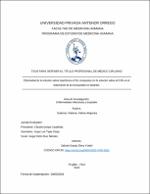| dc.contributor.advisor | Salcedo Espejo, Elena Ysabel | |
| dc.contributor.author | Gutiérrez Valdivia, Fátima Alejandra | |
| dc.creator | Gutiérrez Valdivia, Fátima Alejandra | |
| dc.date.accessioned | 2024-03-26T21:32:40Z | |
| dc.date.available | 2024-03-26T21:32:40Z | |
| dc.date.issued | 2024 | |
| dc.identifier.uri | https://hdl.handle.net/20.500.12759/25311 | |
| dc.description.abstract | Objetivo: Determinar la efectividad de la solución salina hipertónica al 3%
comparada con la solución salina al 0.9% en el tratamiento de la bronquiolitis
en lactantes.
Material y métodos: Se llevó a cabo un estudio de tipo analítico, de cohorte
retrospectiva, cuya muestra estuvo compuesta por 126 lactantes con
bronquiolitis atendidos en el Hospital Belén de Trujillo, de los cuales, 63
recibieron solución salina hipertónica al 3% nebulizada y los otros 63,
recibieron solución salina al 0.9%. Se recogieron los datos de las historias
clínicas para después realizar un análisis estadístico que incluyó las pruebas
de Chi cuadrado, así como el T de student.
Resultados: El análisis arrojó que, en cuanto al tiempo de estancia
hospitalaria, los que recibieron tratamiento con SSH al 3%, tuvieron un
tiempo promedio de estancia de 13,9 + 7,9 horas, mientras que, en quienes
se utilizó la solución salina al 0.9% obtuvieron en promedio 17,4 + 6,2 horas
(p=0.007). En lo referente al tiempo requerido de oxigenoterapia, aquellos
que recibieron SSH al 3% utilizaron en promedio 9,5 + 9,5 horas de oxígeno,
mientras que aquellos que recibieron SSF requirieron en promedio 13,5 + 9,3
(p=0.020). Finalmente, se describe la mejora del cuadro clínico determinada
por un puntaje menor o igual a 3 en el Score de Bierman y Pierson en las
primeras 24 horas, existiendo dos veces más probabilidades de obtener
mejoría clínica usando SSH al 3% que utilizando la SSF, apreciándose la
mejoría en el 57.1% y el 23,8% de los que recibieron SSH al 3% y SS al
0.9%, respectivamente (p=0,000).
Conclusión: La administración de la solución salina hipertónica al 3%
nebulizada comparada con la solución salina al 0.9% en el tratamiento de la
bronquiolitis en lactantes tuvo mayor efectividad en el menor tiempo de
estancia hospitalaria, menor tiempo de requerimiento de oxígeno y mayor
rapidez en la mejora del Score de Bierman y Pierson a las 24 horas de
ingreso hospitalario | es_PE |
| dc.description.abstract | Objective: Determine the effectiveness of 3% hypertonic saline compared to
0.9% saline in the treatment of bronchiolitis in infants.
Material and methods: An analytical, retrospective cohort study was carried out,
whose sample was composed of 126 infants with bronchiolitis treated at the Belén
Hospital in Trujillo, of which, 63 received nebulized 3% hypertonic saline solution
and the another 63 received 0.9% saline solution. Data were collected from the
medical records and then performed a statistical analysis that included the Chi
square tests, as well as the Student's T test.
Results: The analysis showed that, in terms of hospital stay time, those who
received treatment with 3% SSH had an average stay time of 13.9 + 7.9 hours,
while those who received the solution 0.9% saline obtained an average of 17.4 +
6.2 hours (p=0.007). Regarding the time required for oxygen therapy, those who
received 3% SSH used an average of 9.5 + 9.5 hours of oxygen, while those who
received SSF required an average of 13.5 + 9.3 (p=0.020 ). Finally, the
improvement of the clinical condition determined by a score less than or equal to
3 in the Bierman and Pierson Score in the first 24 hours is described, with twice
the probability of obtaining clinical improvement using 3% SSH than using SSF.
The improvement was seen in 57.1% and 23.8% of those who received SSH at
3% and SS at 0.9%, respectively (p=0.000).
Conclusion: The administration of nebulized 3% hypertonic saline solution
compared to 0.9% saline solution in the treatment of bronchiolitis in infants was
more effective in the shorter hospital stay, shorter oxygen requirement time and
faster recovery. the improvement of the Bierman and Pierson Score 24 hours
after hospital admission | es_PE |
| dc.description.uri | Tesis | es_PE |
| dc.format | application/pdf | es_PE |
| dc.language.iso | spa | es_PE |
| dc.publisher | Universidad Privada Antenor Orrego | es_PE |
| dc.relation.ispartofseries | T_MED_3787 | |
| dc.rights | info:eu-repo/semantics/openAccess | es_PE |
| dc.rights.uri | https://creativecommons.org/licenses/by/4.0/ | es_PE |
| dc.source | Repositorio Institucional - UPAO | es_PE |
| dc.source | Universidad Privada Antenor Orrego | es_PE |
| dc.subject | solución salina al 0.9% | es_PE |
| dc.subject | solución salina hipertónica al 3% | es_PE |
| dc.subject | bronquiolitis | es_PE |
| dc.title | Efectividad de la solución salina hipertónica al 3% comparada con la solución salina al 0.9% en el tratamiento de la bronquiolitis en lactantes | es_PE |
| dc.type | info:eu-repo/semantics/bachelorThesis | es_PE |
| thesis.degree.level | Título Profesional | es_PE |
| thesis.degree.grantor | Universidad Privada Antenor Orrego. Facultad de Medicina Humana | es_PE |
| thesis.degree.name | Médico Cirujano | es_PE |
| thesis.degree.discipline | Medicina Humana | es_PE |
| dc.subject.ocde | https://purl.org/pe-repo/ocde/ford#3.02.27 | es_PE |
| renati.advisor.orcid | https://orcid.org/0000-0003-4700-3551 | es_PE |
| renati.author.dni | 71320546 | |
| renati.advisor.dni | 17808298 | |
| renati.type | https://purl.org/pe-repo/renati/type#tesis | es_PE |
| renati.level | https://purl.org/pe-repo/renati/level#tituloProfesional | es_PE |
| renati.discipline | 912016 | es_PE |
| renati.juror | Quispe Castañeda, Claudia | |
| renati.juror | Tapia Zerpa, Jorge Luis | |
| renati.juror | Ruiz Méndez, Ángel Pedro | |
| dc.publisher.country | PE | es_PE |




